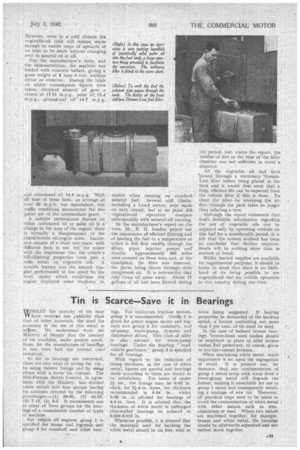Tin is Scarce—Save it in Bearings
Page 25

If you've noticed an error in this article please click here to report it so we can fix it.
WHILST the scarcity of tin may W have received less publicity than that of other materials, the need for economy. in the use of this metal is intent. We understand-from the Ministry of supply. that the amount of tin available, under present conditions, for the manufacture of bearifigs is less than half the normal con-suinption.
. So far as bearings are concerned, there are,two ways of saving tin, viz., by using thinner linings and by using alloys with a lower tin content. The Nbn-Ferrous Metals Control, in agreement With the Ministry, "hasdivided white metals into four groups having tin contents denoted by the following percentages:----(1) 80-92, (2) 63-75, (3) 7-12, (4) 0-5. It recommends one or other of these groups for the bearings of a considerable number of types of machine.
For vehicle oil engines, group 1 is specified for mains and big-ends and group 3 for camshaft and other bear
ings. For trolleybus traction motors, group 3 is recommended. Ciotti) 1 is given for petrol engine mains and bigends and group 3 for camshafts, and oil-pump, water-pump, dynamo and distributor drives. This class of alloy is also advised for water-pump bearings. Under the heading " roadvehicle gearboxes," group 3 is specified for all bearings.
With regard to the reduction of lining thickness, in the case of white metal, figures are quoted and bearings made according to them are stated to be satisfactory. For bores of under ins., the linings may. be 0.03 in.
thick; for bores, the thickness recommended is 0.04 in., whilst 0.06 in. _.is advised for bearings of 4-6-in. bore. It is advised that the thickness of white metal in unflanged thin-walled. hearings be reduced to 0.010-0.015 in.
Whenever possible, it is stressed that the materials used for backing the white metal should be tin free, steel or brass being suggested. If bearing properties be demanded of the backing metal, a bronze containing not more than 5 per cent, of tin muSt be used. • _In the case of "unlined bronze bearings, bronze-lined steel bushes should he employed in place of solid bronze bushes Ind preference, of course, given _to low-tin-content bronzes.
When machining white metal, much importance is set upon the segregation of Swart. 'It is pointed out, for instance, that any contamination of 'group 1 metal scrap with scrap froth a lower-group metal will degrade the " former, making it unsuitable for use as group 1 metal and consequently entailing a wastage of new tin. Moreover, all practical steps need to be taken to avoid the contamination of white metal .! with other metals such as zinc, aluminium or steel. Where two metals are machined . together, for example. ' bronze and white metal, the turnings should be afterwards separated and not melted down together.




















































